A collection of videos relating to the diagnosis and treatment of eye movement disorders. This collection includes many demonstrations of examination techniques.
Dan Gold, D.O., Associate Professor of Neurology, Ophthalmology, Neurosurgery, Otolaryngology - Head & Neck Surgery, Emergency Medicine, and Medicine, The Johns Hopkins School of Medicine.
A collection of videos relating to the diagnosis and treatment of eye movement disorders.
NOVEL: https://novel.utah.edu/
TO
Filters: Collection: ehsl_novel_gold
| Title | Description | Type | ||
|---|---|---|---|---|
| 1 |
 |
Saccadic Pathways in the Brainstem and Cerebellum & Mechanism for Saccadic Dysmetria in Wallenberg Syndrome - Abnormal Function of the Brainstem/Cerebellar Saccadic Pathways with a Left Wallenberg Syndrome | The end result of a lesion involving the climbing fibers within the left lateral medulla is deficient rightward saccades (contralesional hypometric saccades), and over-active leftward saccades (ipsilesional hypermetric saccades), and ipsilesional ocular lateropulsion given this baseline imbalance. M... | Image |
| 2 |
 |
Curved Oblique Saccades and Saccadic Slowing in a Patient with an Anti-GAD Mediated Posterior Fossa Syndrome | This is a patient who developed muscle spasms especially involving the muscles of the trunk in addition to a progressive gait disorder. Examination demonstrated slow saccades, slower horizontally than vertically, in addition to gaze evoked nystagmus with a side pocket pattern. Side pocket nystagmu... | Image/MovingImage |
| 3 |
 |
Bilateral INOs Due to Stroke | This is a 65-year-old man with multiple vascular risk factors who experienced the abrupt onset of diplopia 6 months prior to this video. MRI done within 24 hours of onset was unremarkable. Examination demonstrated subtle bilateral adduction lag with horizontal saccades. There was very mild abducting... | Image/MovingImage |
| 4 |
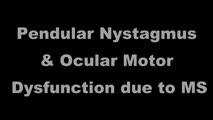 |
Pendular Nystagmus and Ocular Motor Signs in MS | 𝗢𝗿𝗶𝗴𝗶𝗻𝗮𝗹 𝗗𝗲𝘀𝗰𝗿𝗶𝗽𝘁𝗶𝗼𝗻: This is a 30-year-old man with a 15 year history of multiple sclerosis. For the last 12 months, he experienced horizontal oscillopsia. On examination, there were ocular motor abnormalities including gaze-evoked nystagmus,... | Image/MovingImage |
| 5 |
 |
Acquired Elliptical Pendular Nystagmus Suppressed by Blinks and Saccades | 𝗢𝗿𝗶𝗴𝗶𝗻𝗮𝗹 𝗗𝗲𝘀𝗰𝗿𝗶𝗽𝘁𝗶𝗼𝗻: This is a 70-year-old man who experienced the gradual onset of oscillopsia over weeks about 3 months prior to this video recording. Examination demonstrated elliptical pendular nystagmus which was atypical for infantile n... | Image/MovingImage |
| 6 |
 |
Saccadic Pathways in the Brainstem and Cerebellum & Mechanism for Saccadic Dysmetria in Wallenberg Syndrome - Normal Function of the Brainstem/Cerebellar Saccadic Pathways | The inferior cerebellar peduncle (ICP) carries climbing fibers to the dorsal vermis, and these fibers have an inhibitory influence over the Purkinje cells. These Purkinje cells normally inhibit the ipsilateral fastigial nucleus, and the fastigial nucleus projects to the contralateral inhibitory burs... | Image |
| 7 |
 |
Gaze-Evoked Nystagmus & Slow Saccades Due to Anti-GAD Antibodies in a Patient with Stiff Person Syndrome | This is a 70-year-old woman with a several year long history of imbalance and stiffness. Exam demonstrated axial and lower extremity stiffness, and ocular motor exam demonstrated gaze-evoked nystagmus (e.g., right-beating in right gaze, left-beating in left gaze, up-beating in up gaze), and mild to ... | Image/MovingImage |
| 8 |
 |
Pseudo-INOs in Myasthenia Gravis | This is a 55-yo-woman with an intermittent exotropia who had normal adduction OU, but clear lag of adducting saccades OD>OS with rapid horizontal saccades. This was much more apparent after repeat testing (ie, it was fatigable), and she wound up having ocular MG. | Image/MovingImage |
| 9 |
 |
Slow Abducting Saccade in 6th Nerve Palsy | 40-yo-man with a right fascicular 6th nerve palsy due to stroke. There was improvement and only a minimal residual right abduction paresis OD by this visit, but still a relatively slow right abducting saccade seen in the video, especially apparent in the slow motion segment. Video shows slow abduct... | Image/MovingImage |
| 10 |
 |
Saccadic Hypermetria and Ipsipulsion (Behind Closed Eyelids and with Vertical Saccades) | 𝗢𝗿𝗶𝗴𝗶𝗻𝗮𝗹 𝗗𝗲𝘀𝗰𝗿𝗶𝗽𝘁𝗶𝗼𝗻: This is a 40-year-old woman who experienced oscillopsia and vertical diplopia, due to spontaneous torsional nystagmus and a skew deviation (right hypotropia), respectively. The symptom onset was 7 months prior to these vi... | Image/MovingImage |
| 11 |
 |
Unidirectional Nystagmus in Lateral Medullary Syndrome | This is a 70-yo-man who presented with acute vertigo. Examination demonstrated very mild spontaneous torsional nystagmus (towards the right ear) in primary (not seen well in this video), with robust downbeat-torsional (towards right ear) nystagmus in right gaze and (less robust) almost pure torsiona... | Image/MovingImage |
| 12 |
 |
Wall-eyed Bilateral INO in Caudal Midbrain Lesion | This is a 30-yo-woman with the relatively acute onset of diplopia. There was a large angle exotropia, very subtle lag of the adducting saccades OD>OS, suggestive of bilateral INOs. This was best seen with rapid horizontal saccades, and a lesion involving bilateral MLFs in the caudal midbrain was dem... | Image/MovingImage |
| 13 |
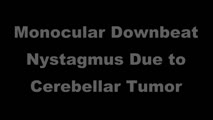 |
Monocular Downbeat Nystagmus Due to a Posterior Fossa Cyst | This is a 40-yo-man who experienced months of imbalance and was found to have an epidermoid cyst (immediately posterior to the 4th ventricle), which was resected. Months after surgery, he experienced monocular vertical oscillopsia. On examination, there was subtle downbeat nystagmus (DBN) in the rig... | Image/MovingImage |
| 14 |
 |
Complete Saccadic Palsy Due to Pulmonary Thrombectomy | 𝗢𝗿𝗶𝗴𝗶𝗻𝗮𝗹 𝗗𝗲𝘀𝗰𝗿𝗶𝗽𝘁𝗶𝗼𝗻: This is a 37-year-old woman who underwent pulmonary thrombectomy for a pulmonary embolus. Immediately following the procedure, she was unable to make normal eye movements. This video exam (she is the passenger in a car du... | Image/MovingImage |
| 15 |
 |
Internuclear Ophthalmoplegia (INO) in Multiple Sclerosis | 𝗢𝗿𝗶𝗴𝗶𝗻𝗮𝗹 𝗗𝗲𝘀𝗰𝗿𝗶𝗽𝘁𝗶𝗼𝗻: This video includes 3 patients each with a known history of MS found to have unilateral or bilateral INOs on their exam. In the first 2 patients, the INOs are relatively subtle with normal adduction. However, with rapid h... | Image/MovingImage |
| 16 |
 |
INOs in Stroke | 𝗢𝗿𝗶𝗴𝗶𝗻𝗮𝗹 𝗗𝗲𝘀𝗰𝗿𝗶𝗽𝘁𝗶𝗼𝗻: This video shows 3 patients with vascular risk factors who suffered strokes of the MLF resulting in unilateral INO in each case. In the second case, INO was diagnosed status post cardiac catherization and MRI was found to... | Image/MovingImage |
| 17 |
 |
Mesodiencephalic Stroke Causing Unilateral riMLF and INC Ocular Motor Syndromes | 𝗢𝗿𝗶𝗴𝗶𝗻𝗮𝗹 𝗗𝗲𝘀𝗰𝗿𝗶𝗽𝘁𝗶𝗼𝗻: This is a 65-year-old man who experienced the sudden onset of diplopia (with horizontal and vertical components), dysarthria and imbalance. An MRI performed the following day showed a left mesodiencephalic stroke. The pat... | Image/MovingImage |
| 18 |
 |
PSP with Vertical Gaze Palsy, Abnormal Optokinetic Nystagmus and Inability to Suppress Blinking to Light | 𝗢𝗿𝗶𝗴𝗶𝗻𝗮𝗹 𝗗𝗲𝘀𝗰𝗿𝗶𝗽𝘁𝗶𝗼𝗻: This is a 75-year-old woman with a diagnosis of progressive supranuclear palsy (PSP). Examination demonstrated vertical supranuclear gaze palsy (i.e., it could be overcome by the vertical vestibulo-ocular reflex [VOR]), s... | Image/MovingImage |
| 19 |
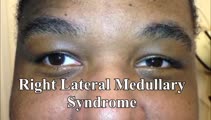 |
Saccadic Dysmetria and Ocular Lateropulsion in Lateral Medullary Stroke | 𝗢𝗿𝗶𝗴𝗶𝗻𝗮𝗹 𝗗𝗲𝘀𝗰𝗿𝗶𝗽𝘁𝗶𝗼𝗻: This is a 30-yo-man who suffered a right lateral medullary stroke. Examination showed saccadic hypermetria to the right (ipsilesional), hypometria to the left (contralesional)and rightward ocular lateropulsion (ipsilesion... | Image/MovingImage |
| 20 |
 |
Square Wave Jerks and Macrosaccadic Oscillations in a Patient with a Cerebellar Tumor | This is a 40-year-old man who developed severe headaches, confusion, and gait imbalance which led to neuroimaging which demonstrated a midline cerebellar mass with compression of the fourth ventricle and obstructive hydrocephalus. He underwent a suboccipital craniectomy for resection of the mass, an... | Image/MovingImage |
| 21 |
 |
Two Patients with Parinaud's Syndrome with Slow Upward Saccades and Normal Upward Range of Movements | Presented here are two patients with Parinaud's syndrome: Patient 1) suffered a hemorrhage of the dorsal midbrain causing slow upward saccades (with convergence retraction nystagmus, but normal vertical range of eye movements), and light-near dissociation, and Patient 2) had a germinoma of the dorsa... | Image/MovingImage |
| 22 |
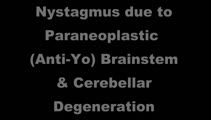 |
Nystagmus Due to Paraneoplastic (Anti-Yo) Brainstem and Cerebellar Degeneration | 𝗢𝗿𝗶𝗴𝗶𝗻𝗮𝗹 𝗗𝗲𝘀𝗰𝗿𝗶𝗽𝘁𝗶𝗼𝗻: This is a 40-yo-woman with anti-Yo antibody associated with ovarian cancer. Initial symptoms 2.5 years prior (to this video) included imbalance and dysarthria. She complained of oscillopsia which was due to her upbeat nys... | Image/MovingImage |
| 23 |
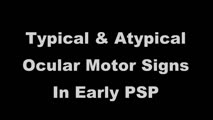 |
Atypical Ocular Motor Features (Gaze-evoked Nystagmus) in PSP | This is a 70-yo-woman who met clinical and radiologic diagnostic criteria for progressive supranuclear palsy (PSP). Typical ocular motor features of PSP include square wave jerks, hypometric saccades, choppy pursuit/VORS, impaired down>upgaze (supranuclear in origin) and impaired down>upward saccade... | Image/MovingImage |
| 24 |
 |
Test Your Knowledge - Oscillopsia | This 65-year-old man with multiple sclerosis described that objects in front of him appear to spontaneously jump or move horizontally for the last few months. He reported that his symptoms occur independent of head movements and head impulse testing was normal. After viewing the video, what is the m... | Image/MovingImage |
| 25 |
 |
Saccades | 𝗢𝗿𝗶𝗴𝗶𝗻𝗮𝗹 𝗗𝗲𝘀𝗰𝗿𝗶𝗽𝘁𝗶𝗼𝗻: The examiner should note: conjugacy (a lag of the adducting eye may be seen with an INO); accuracy (posterior fossa lesions commonly produce dysmetria (overshooting or undershooting); velocity (if slow, may suggest a lesi... | Image/MovingImage |
